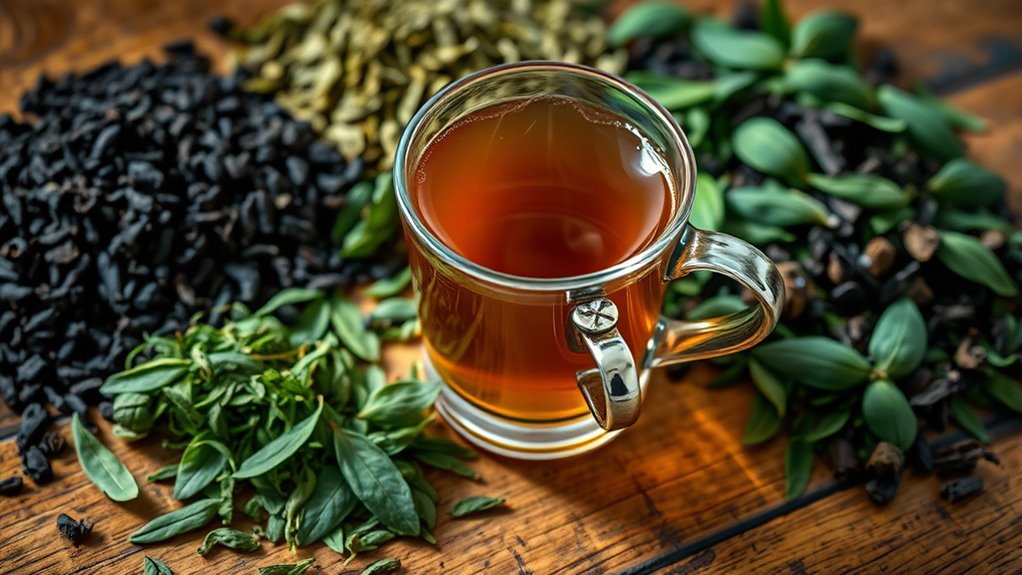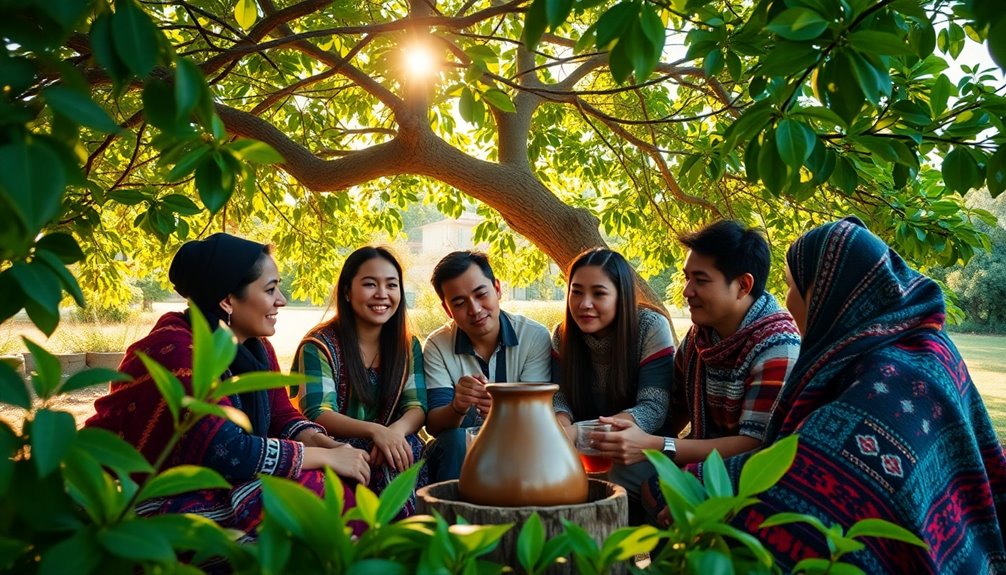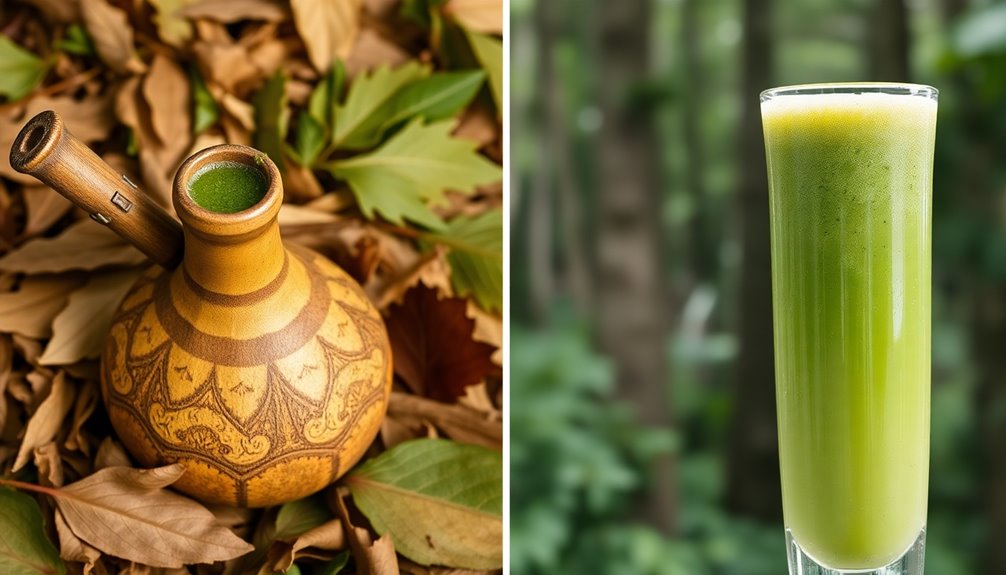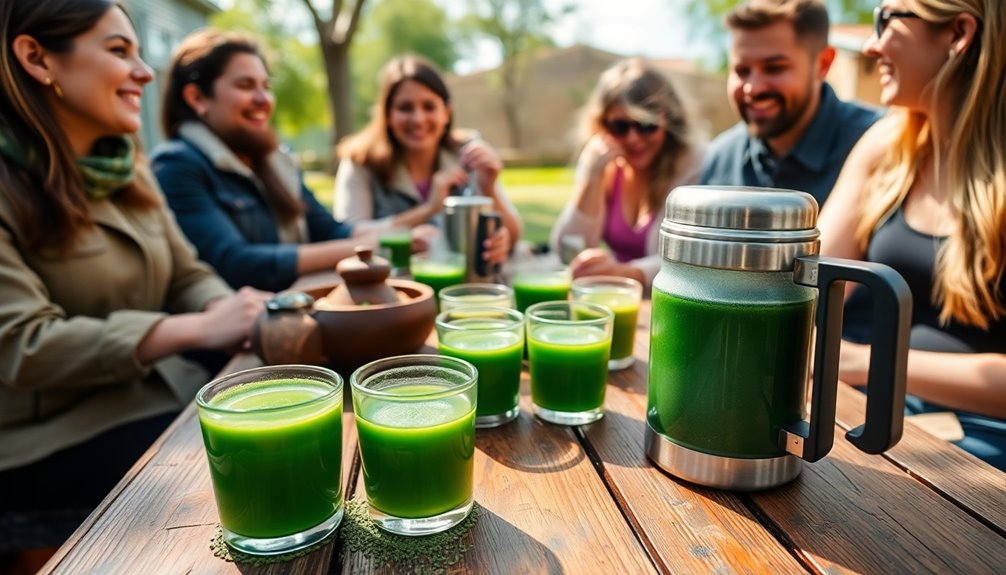South American teas like yerba mate stand out for their bold, earthy flavors and traditional, communal brewing methods. Unlike Asian teas, which are often delicate and prepared individually, South American styles emphasize slow, social rituals, enhancing their cultural significance. The preparation preserves natural compounds that boost energy and health benefits. If you explore further, you’ll discover how these unique customs create a vibrant, wholesome experience different from other global teas.
Key Takeaways
- South American teas like yerba mate are brewed in gourds with a metal straw, emphasizing slow, communal rituals, unlike Asian teas’ individual steeping methods.
- They have a robust, earthy, and grassy flavor profile, contrasting with the delicate or floral notes of many Asian teas.
- Preparation methods preserve bioactive compounds, offering health benefits such as high antioxidants, mental clarity, and anti-inflammatory effects.
- Sharing mate is a social ritual that fosters community, whereas traditional Asian teas often focus on individual mindfulness and ceremonial practices.
- South American teas are generally more earthy and robust, with slow, social brewing, differing significantly from the often quick, individual Asian tea rituals.
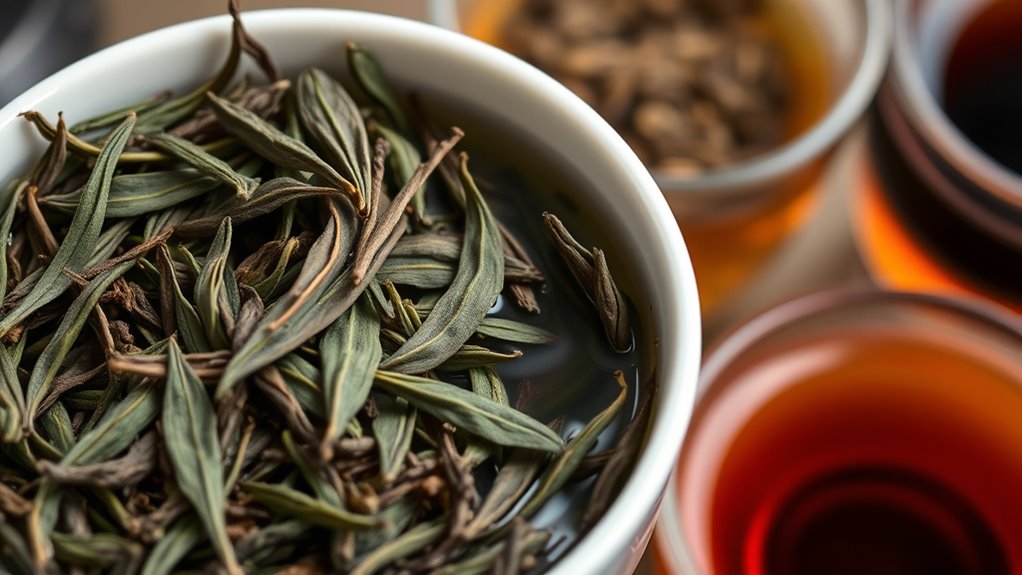
South America offers a diverse array of teas, each with unique flavors and cultural significance. As you explore these regional drinks, you’ll notice that many South American teas are valued not just for their taste but also for their health benefits. For instance, yerba mate, one of the most popular beverages in countries like Argentina, Uruguay, and Paraguay, is celebrated for its high antioxidant content and ability to boost energy and focus. Drinking yerba mate regularly might help improve mental clarity and reduce fatigue, making it a popular alternative to coffee. Unlike traditional teas from Asia, which often involve steeping leaves in hot water for a few minutes, yerba mate is typically brewed in a gourd using a metal straw called a bombilla. The brewing method involves adding hot but not boiling water to the loose leaves, allowing you to enjoy multiple infusions that preserve the tea’s complex flavor profile. This method emphasizes a social experience, where sharing mate becomes a communal ritual. The preparation techniques also influence the tea’s flavor profile, creating a rich and earthy taste that distinguishes South American teas from other varieties worldwide.
In comparison to other teas, South American varieties often require different brewing techniques that influence both flavor and health benefits. For example, Brazilian chimarrão, a close relative of yerba mate, is prepared similarly but tends to have a slightly different flavor, often described as earthy and grassy. The brewing process involves filling a gourd with yerba mate and adding hot water gradually, which extracts the nutrients and antioxidants while maintaining the tea’s invigorating qualities. These brewing methods are key to releasing the full spectrum of health benefits, as they help preserve the natural compounds responsible for boosting immunity and reducing inflammation.
When you compare South American teas to traditional teas like green, black, or white from Asia or Africa, you’ll find that their preparation often emphasizes social interaction and a distinctive ritual. South American teas tend to be more robust and earthy, offering a different set of antioxidants and phytochemicals. The health benefits are comparable in some ways—improving alertness, aiding digestion, and providing anti-inflammatory effects—but the brewing methods are often more communal and slow-paced. This creates a different sensory experience and a unique cultural connection.
In essence, exploring South American teas means embracing more than just their flavors; it’s about understanding the brewing methods that enhance their health benefits and cultural significance. Whether you’re brewing a strong mate infusion or trying a different regional preparation, you’re participating in a tradition that’s deeply rooted in social and health-oriented practices. This sets South American teas apart from their counterparts elsewhere, offering a distinctive experience that combines wellness with cultural richness.
Frequently Asked Questions
What Are the Health Benefits Unique to South American Teas?
South American teas offer unique health benefits you won’t find elsewhere. They are rich in antioxidant properties, helping protect your cells from damage and supporting overall health. These teas also provide digestive benefits, soothing your stomach and aiding digestion after meals. Drinking South American teas can boost your immune system and improve your well-being. Incorporate them into your routine to enjoy these natural health advantages and enhance your daily wellness.
How Does the Flavor Profile of South American Tea Differ From Asian Teas?
Imagine tasting a South American tea like yerba mate, where your palate notices bold, earthy flavor nuances that differ from the delicate, floral notes of Asian teas like jasmine green. You’ll find that brewing techniques influence these differences—longer steeps bring out robustness in South American teas, while shorter infusions highlight subtlety in Asian varieties. This contrast creates a unique, vibrant experience that highlights regional tea traditions and flavor profiles.
Are South American Teas Suitable for People With Caffeine Sensitivities?
If you’re sensitive to caffeine, South American teas might be suitable because they often have lower caffeine content than traditional Asian teas. However, it varies by type, so check the label or ask about sensitivity considerations. You might find herbal infusions from the region to be a good choice, as they generally contain little to no caffeine, helping you enjoy a warm beverage without overstimulating your system.
What Traditional South American Tea Brewing Methods Exist?
Imagine preparing yerba mate, a traditional South American infusion, by placing dried leaves in a gourd. You then add hot but not boiling water, allowing the leaves to steep slowly. This leaf preparation method emphasizes traditional infusions, where the focus is on the ritual and flavor. You can also try using a bombilla (metal straw) to sip directly, enhancing the authentic experience and respecting the cultural brewing practices.
How Sustainable Is the Cultivation of South American Tea Varieties?
You’ll find that the cultivation of South American tea varieties is increasingly sustainable, thanks to practices like sustainable farming that prioritize preserving local ecosystems. Farmers often reduce chemical use and implement water conservation measures, which minimizes environmental impact. By supporting these methods, you help promote eco-friendly production, ensuring the land remains healthy and productive for future generations. Overall, South American tea cultivation is trending toward more sustainable and environmentally conscious practices.
Conclusion
As you explore South American teas, remember that variety is the spice of life. While they may differ from traditional teas, embracing new flavors broadens your palate and enriches your experience. Don’t forget the saying, “A change of taste is a change of fortune.” So, take a sip, enjoy the journey, and let each cup remind you that sometimes, trying something new is the greatest reward. Cheers to discovering the world in every sip!

